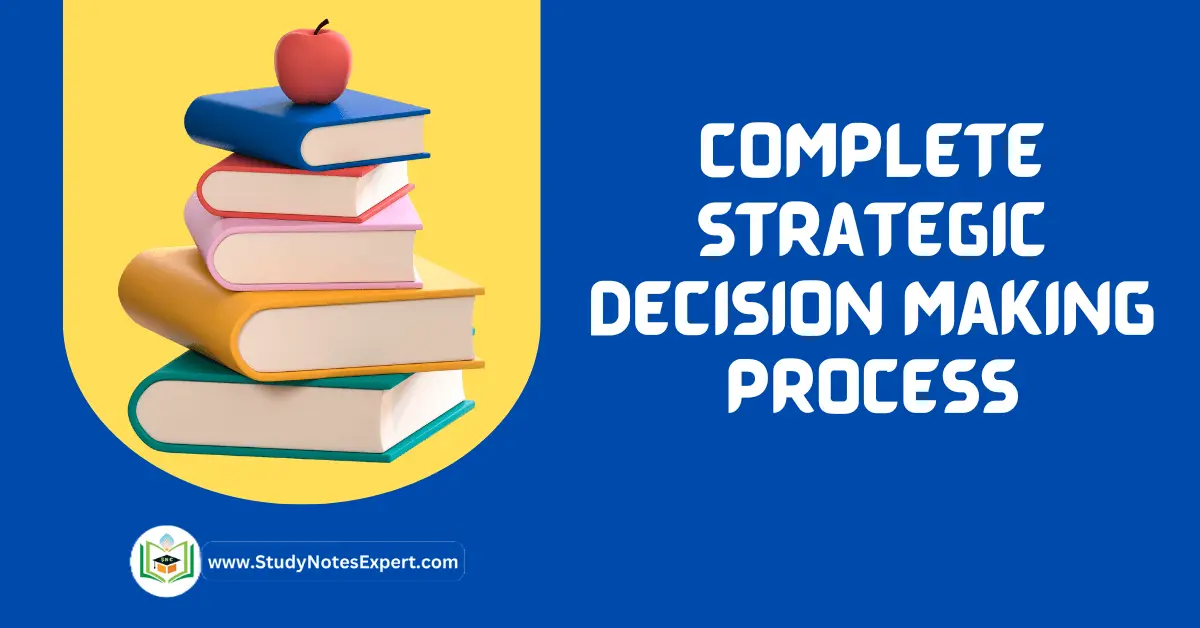right time. This enables the competitors to grab the opportunity and intensify the problem, which becomes a major crisis for the organization. Therefore, making decisions at the right time and implementing them once the problems are analyzed is important. In simple terms, decision-making means arriving at a conclusion and implementing it instantly. Further, in this article, we will explain the strategic decision making process.
Mintzberg states, “Strategic decisions are important, in terms of the actions taken, the resources committed, or the precedents set.”
Strategic Decision Making Process
The steps in the strategic decision making process are as follows:
1) Planning Process
Planning is the process and behavior that leads the activities and directions of an organization to achieve pre-defined goals in a pre-defined time frame. The planning process aims to promote the organizational mission continuously. It is the first step of strategic decision making process model. For example, to be socially constructed, intuitively improvised, politically negotiated, and shaped through emergent behaviors. Seven factors are involved in the process of strategic planning:
i) Decision Parameters
The measurable factors like manpower, material, marketing method, and machine functions that form boundaries for strategic decision-making are referred to as decisions.
ii) Decision Criteria
Decision criteria are the measurement standards, rules, or tests for assessing the parameters and feasibility of activities concerning their effectiveness. These are specific, measurable goals that are derived from the strategic objectives.
iii) Decision Conditionality
These factors condition or enforce restrictions on the effectiveness of organizational activities. The strategic decisions are affected by both internal and external environmental factors.
iv) Decision Alternatives
Decision alternatives are the choices between two options or courses of action. In a decision-making process, when a decision-maker chooses a course of action from the given alternatives, this decision is known as a choice.
v) Technical Model
The technical model has been derived through the use of scientific methodology. Usually, an organization subconsciously or consciously compares the available alternatives derived from subjective probabilities to test the feasibility of each alternative on the grounds of all the objectives and their subjective sides.
vi) Technological Model
This model is a strategic choice associated with an organization’s value-adding system.
vii) Correction Factor
The process of strategic planning should be such that the outcome of the implemented decision is equivalent to the organizational objectives. This is the main reason behind its Occurrence.
2) Programming System
Once the strategic action is planned, it should be programmed. Programming is a system of opportunities, services, and projects sequenced to assist economical and timely strategic action. There must also be a clear schedule of resources required to perform the programmed services, opportunities, and projects. Programming system is a part of the strategic decision making process. The organization acts as a ‘taker of programming activities at the individual and organizational levels in all decision-making situations. Depending on the demand of strategic decision-making, an organization can choose the most appropriate programming or even adopt reprogramming.
3) Performing Modalities
Once the decision regarding the programming is finalized, the next step is to determine the execution of the specific elements of strategic decision-making. However, the programming provides the fundamental heuristic operations, but specific actions must still be performed to attain the desired outcome.
4) Profitability Factor
An organization can competitively execute its strategic decision-making with the help of sound planning, effective performance, and well-organized programming. While the profitability level of the firms’ strategic initiatives depends on their institutional systems, the organizations that wish to go global must consider the institutional systems’ validity and their effects. If required, they can adopt re-institutionalization.
5) Developmental Growth
The decision-making process is decided based on the recurrence of regular schedules. The decision-makers believe that repetition will provide a constant level of profitability. It is the important step of the strategic decision making process. Therefore, they repeat the most profitable strategic decision-making process programmatically. Alternatively, repetition is rare in emerging markets, and if done, then the profits are sustainable. In such markets, the technological endowments of organizations could be more refined. Thus, it is convenient for other firms (whether local or overseas) to acquire, replicate and replace these endowments.

